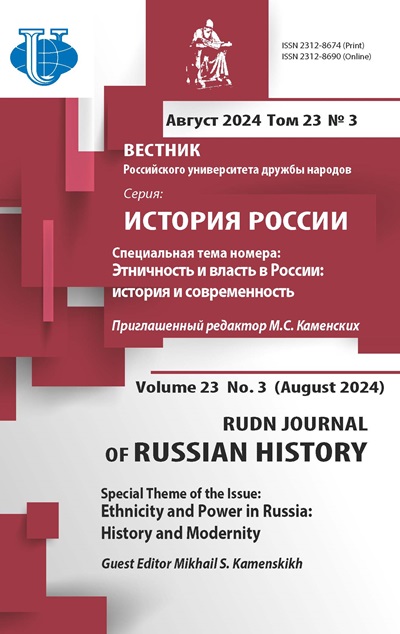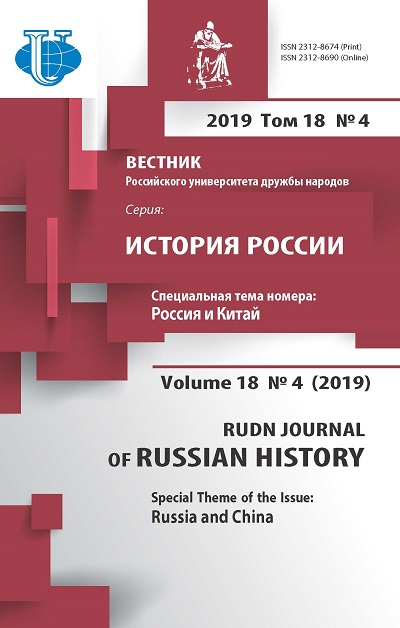Religious features of the ethnic tradition of the Ossetians in the conditions of social modernization of the late 19th and early 20th centuries, according to the folklore legend “The Tale of the Lonely”
- Authors: Ktsoeva S.G.1
-
Affiliations:
- V. I. Abayev North-Ossetian Institute of Humanitarian and Social Studies
- Issue: Vol 18, No 4 (2019): RUSSIA AND CHINA
- Pages: 922-937
- Section: HISTORY OF PEOPLES AND REGIONS OF RUSSIA
- URL: https://journals.rudn.ru/russian-history/article/view/22314
- DOI: https://doi.org/10.22363/2312-8674-2019-18-4-922-937
Cite item
Full text / tables, figures
Abstract
The article analyzes transformation processes in the Ossetian ethnic tradition that resulted from the modernization of the Great Reforms era. While the article covers the late nineteenth and early twentieth centuries, the changes in question stretched beyond these limits, being complex in nature and increasing gradually. As mountainous Ossetia was drawn into the orbit of Russian influence the ethnic isolation was ended, and certain aspects of the tradition changed. The period of Great Reforms contributed to the strengthening of capitalist development in the Russian Empire. This period provided significant changes not only in the economic but also in the socio-cultural life of the Ossetian highlanders. We observe a gradual modernization of the archaic tradition of the ethnos at that time. This transformation of the traditional ethnic worldview of the Ossetian highlanders is reflected in various narrative sources. In particular the folk legends recorded by representatives of the educated part of Ossetian society carry significant information. The bearers of oral folklore - the inhabitants of mountainous Ossetia - often introduced new realities into the narratives, elements that were atypical for the archaic consciousness. Folk legends therefore constitute an important source for studying the processes of modernization of the traditional consciousness. The present article studies these processes with the folklore legend The Tale of the Lonely recorded in the nineteenth century, which reflects ideological transformations characteristic of the ethnic consciousness in this period.
About the authors
Sultana G. Ktsoeva
V. I. Abayev North-Ossetian Institute of Humanitarian and Social Studies
Author for correspondence.
Email: sultana_t@mail.ru
Doktor istoricheskikh nauk [Dr. habil. hist.], Professor at the Department of World History and Historical Political Science, V.I. Abayev North-Ossetian Institute of Humanitarian and Social Studies
10, Mira Ave., Vladikavkaz, 362040, RussiaReferences
- Abayev, V.I. “Dokhristianskaya religiya alan.” In Izbrannyye trudy. Religiya, fol’klor, literature, 102–114. Vladikavkaz: Iriston Publ., 1990 (in Russian).
- Bayev, G. “Skazaniye ob Odinokom (Iunadzhi kadag).” In Periodicheskaya pechat’ Kavkaza ob Osetii i osetinakh, 330–340. Tskhinvali: Iryston Publ., 1982 (in Russian).
- Bayev, G. “Ocherk iz zhizni osetin.” In Periodicheskaya pechat’ Kavkaza ob Osetii i osetinakh, 341–350. Tskhinvali: Iryston Publ., 1982 (in Russian).
- Cox, James L. From Primitive to Indigenous: The Academic Study of Indigenous Religions. Aldershot: Ashgate Publ., 2007.
- Darchiyev, A.V. “Batraz-muravey (ob odnom motive nartovskogo eposa).” Izvestiya SOIGSI, no. 7 (2011): 26–37 (in Russian).
- Dobrolyubov, N.A. Polnoye sobraniye sochineniy. Moscow: Nauka Publ., 1937 (in Russian).
- Eliade, M. Izbrannyye sochineniya. Ocherki sravnitel’nogo religiovedeniya. Moscow: Ladomir Publ., 1999 (in Russian).
- Gutiyeva, E.Sh. Osetinskaya intelligentsiya v epokhu poreformennoy modernizatsii: vtoraya polovina XIX – nachalo XX vv. Vladikavkaz: Severo-Osetinskiy Gosuniversitet Publ., 2013 (in Russian).
- Hinnells, John R. The Routledge companion to the study of religion. London: Routledge Publ., 2005.
- Kanukova, Z.V., and Dzalayeva, K.R. “Khozyaystvenno-kul’turnyy oblik osetinskogo seleniya: traditsiya i yeye poreformennaya modernizatsiya (konets XIX – nachalo XX v.).” In VI Vserossiyskiye millerovskiye chteniya, 242–256. Vladikavkaz: SOIGSI Publ., 2018 (in Russian).
- Khadikova, A.Kh. Etnicheskiye obrazy i traditsionnyye modeli povedeniya osetin. Vladikavkaz: SOIGSI VNTS RAN Publ., 2015 (in Russian).
- Kozolupenko, D.P. Mif na granyakh kul’tury. Moscow: Mif Publ., 2005 (in Russian).
- Ktsoyeva, S.G. “Nekotoryye aspekty transformatsii mirovozzrencheskikh paradigm etnicheskoy religii osetin (vtoraya polovina XIX – nachalo XX veka).” Voprosy istorii, no. 8 (2018): 162–171 (in Russian).
- Lebedinskiy, Yu. Skazaniya o nartakh. Osetinskiy epos. Moscow: Sovetskaya Rossiya Publ., 1978 (in Russian).
- Levi-Stross, K. Strukturnaya antropologiya. Moscow: EKSMO-Press Publ., 2001 (in Russian).
- Lentsman, Ya.A. “Iranskiy kul’t Mitry i kul’t Nepobedimogo solntsa.” In Proiskhozhdeniye khristianstva, 90–120. Moscow: Akademiya nauk SSSR Publ., 1958 (in Russian).
- Miller, V.F. Osetinskiye etyudy. Vladikavkaz: SOIGSI Publ., 1992 (in Russian).
- Shanayev, Dzh. T. “Prisyaga po obychnomu pravu osetin.” In Periodicheskaya pechat’ Kavkaza ob Osetii i osetinakh, 455–469. Vladikavkaz: SOIGSI Publ., 2014 (in Russian).
- Sobolev, A.N. Mifologiya slavyan. Zagrobnyy mir po drevnerusskim predstavleniyam. St. Petersburg: Lan’ Publ., 1999 (in Russian).
- Tuallagov, A.A. “Nartovskiy Batraz i istoriya khristianstva u alan.” In Problemy osetinskogo nartovskogo eposa, 217–231. Vladikavkaz: SOIGSI Publ., 2000 (in Russian).
- Tuayeva, B.V., Kanukova, Z.V., Usova, Yu.V., and Pliyeva, Z.T. “Remeslenniki v soslovnoy strukture gorodov Severnogo Kavkaza.” Russian Historical Journal Bylye Gody, no. 2 (44) (2017): 378–386 (in Russian).
- Uarziati, V.S. Prazdnichnyy mir osetin. Vladikavkaz: SOIGSI Publ., 1995 (in Russian).
















